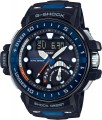Dial colour
Clock face background colour. Indicated for models with pointer or combination dials (see "Dial type"); in purely electronic models, usually, either a grey substrate (for conventional LCDs) or a dark base (for LEDs) is used.
The most popular in modern watches are
black,
white,
silver and
blue dials. However, in addition to this, other shades can be found on the market — in particular,
beige,
yellow,
green,
golden,
brown,
red,
orange,
pink,
grey and
purple. A special case are watches with chameleon glasses (see below).
Some models are available in several colour options, in such cases these options are listed separated by commas — for example, "white, red, silver." If the dial is painted simultaneously in 2 or 3 colours, they are indicated as a combination — for example, "white with red" or "white with yellow and red". And multi-coloured models include models in which more than 3 colours are used for the dial.
Colour
The main colour of the watch case.
Modern watches are quite diverse in colour options. The most widespread models are in shades of "
stainless steel ",
golden and
black ; however, in addition to this, on the market you can find, in particular,
white,
yellow,
green,
brown,
red,
orange,
pink,
silver,
grey,
blue and
purple cases.
In general, the colour of the case is a fairly obvious parameter; Let's note only some of the nuances associated with marking:
— Multi-coloured models include models in which there is no clearly defined primary colour. If there is such a colour, it is indicated in the characteristics. And for two-tone cases, an additional colour can be specified, for example, "stainless steel
with gold " or "black
with blue "
— Silver, among other things, are plastic cases without additional coloring.
— "Stainless steel" in this case is a colour, not a material; other metals (e.g. alumin
...ium and titanium) that are not complemented by PVD coating (see “Case Coating”) may have this shade. And the cases of gold watches, in turn, are not necessarily made of gold — red and white gold are also used in jewelry.
— Camouflage coloring is indicated separately — such watches are designated as "military", and here, again, the main shade of the coloring is given. However, not every military model has camouflage on the body; see below for details.Diameter (width)
The nominal size of a watch case in diameter (for round cases) or width (for other options, see "Case Shape"). In the most miniature modern models, this size is
21 – 25 mm or even
less, among the largest there are cases of
46 – 50 mm and even
larger.
Larger watches are more convenient in the sense that the dial readings are better visible on them, and it is easier to provide various additional functions in the design. On the other hand, small watches look neater and create less discomfort directly when worn. In addition, female models (see "Gender") are traditionally made more miniature than male ones. So the choice for this indicator depends mainly on the intended specifics of the application: for example, large cases are best suited for outdoor activities and tourism, about
41 – 45 mm in size, for household wear (regardless of gender) — about
31 – 35 mm, and as an accessory to an evening dress, a small watch of
30 mm or less would be more appropriate.
Also note that the size of a compatible strap/bracelet is associated with this indicator — see "Strap Width" for details.
Thickness
The thickness of the watch case. A fairly obvious parameter; we only note that nowadays it is customary to attribute watches with a thickness of less than 7 mm to
ultra-thin models. This design has both aesthetic and quite practical meaning — a thin watch will be useful for those who wear narrow sleeves with tight-fitting cuffs.
Weight
Total weight of the watch. As a rule, it is indicated taking into account the complete strap/bracelet.
The lightest modern watch weighs
no more than 50 g. The most popular models weigh 50 - 100 g, and weight more than 150 g most often means not only a large, but also a fairly advanced device, usually for sports and tourism purposes.
Both light and heavy weight have their advantages: light watches create minimal inconvenience when worn, while massive watches are subconsciously perceived as a solid and reliable device.

